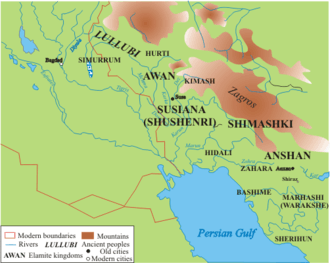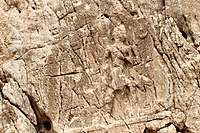Simurrum
The Simurrum Kingdom (Akkadian: 𒋛𒈬𒌨𒊑𒅎: Si-mu-ur-ri-im)[1] was an important city state of the Mesopotamian area from around 2000 BCE to 1500 BCE, during the period of the Akkadian Empire down to Ur III. The Simurrum Kingdom disappears from records after the Old Babylonian period.[2] It was neighbour and sometimes ally with the Lullubi kingdom.[3]
Simurrum Kingdom 𒋛𒈬𒌨𒊑𒅎 | |
|---|---|
| 2000 BCE–1500 BCE | |
 Territory of Simurrum in the Mesopotamia area. | |
| Common languages | Unclassified Akkadian (inscriptions) |
| Religion | Mesopotamian religions |
| Government | Monarchy |
| Historical era | Antiquity |
• Established | 2000 BCE |
• Disestablished | 1500 BCE |
| Today part of | Iraq |
Kingdom
.jpg)
The Simurrum Kingdom seems to have been part of a belt of Hurrian city states in the northeastern portion of Mesopotamian area.[2] They were often in conflict with the rulers of Ur III.[2][4]
Several Kings (𒈗, pronounced Šàr, "Shar", in Akkadian)[5] of Simurrum are known, such as Iddin-Sin and his son Zabazuna.[2] Various inscriptions suggest that they were contemporary with king Ishbi-Erra (1953—c.1920 BCE).[4]
Conflicts
Several inscriptions suggest that Simurrum was quite powerful, and shed some light on the conflicts around the Zagros area, another such example being the Anubanini rock relief of the nearby Lullubi Kingdom.[2] Four inscriptions and a relief (now in the Israel Museum) of the Simurrum have been identified at Bitwata near Ranya in Iraq, and one from Sarpol-e Zahab in Iran.[4][6]
The Simurrun were regularly in conflict with the Akkadian Empire. The names of four years of the reign of Sargon of Akkad describe his campaigns against Elam, Mari, Simurrum, and Uru'a (an Elamite city-state):[7][8]
One unknown year during the reign of Akkadian Empire king Naram-Sin of Akkad was recorded as "the Year when Naram-Sin was victorious against Simurrum in Kirasheniwe and took prisoner Baba the governor of Simurrum, and Dubul the ensi (ruler) of Arame".[11]
After the Akkadian Empire fell to the Gutians, the Lullubians and the Simurrums rebelled against the Gutian ruler Erridupizir, according to the latter's inscriptions:
Ka-Nisba, king of Simurrum, instigated the people of Simurrum and Lullubi to revolt. Amnili, general of [the enemy Lullubi]... made the land [rebel]... Erridu-pizir, the mighty, ling of Gutium and of the four quarters hastened [to confront] him... In a single day he captured the pass od Urbillum at Mount Mummum. Further, he captured Nirishuha.
— Inscription R2:226-7 of Erridupizir.[12]
At one point, Simurrum may have become a vassal of the Gutians.[2] Simurrum seems to have become independent after the collapse of Ur III.[4]
.jpg) King Iddin-Sin of the Kingdom of Simurrum, holding an axe and a bow, trampling a foe. Circa 2000 BCE. Israel Museum
King Iddin-Sin of the Kingdom of Simurrum, holding an axe and a bow, trampling a foe. Circa 2000 BCE. Israel Museum Stela of Iddi-Sin, King of Simurrum. It dates back to the Old-Babylonian Period. From Qarachatan Village, Sulaymaniyah Governorate, Iraqi Kurdistan. The Sulaymaniyah Museum, Iraq
Stela of Iddi-Sin, King of Simurrum. It dates back to the Old-Babylonian Period. From Qarachatan Village, Sulaymaniyah Governorate, Iraqi Kurdistan. The Sulaymaniyah Museum, Iraq
.jpg) Outline of relief I (extracted). Beardless warrior with axe, trampling a foe. Sundisk above. A name "Zaba(zuna), son of ..." can be read.[13]
Outline of relief I (extracted). Beardless warrior with axe, trampling a foe. Sundisk above. A name "Zaba(zuna), son of ..." can be read.[13]
See also
Part of a series on the |
|---|
| History of Iraq |
.jpg) |
|
|
|
|
| Wikimedia Commons has media related to Simurrum. |
- Anobanini rock relief
References
- Shaffer, Aaron (2003). Iddi(n)-Sîn, King of Simurrum: A New Rock-Relief Inscription and a Reverential Seal. Zeitschrift für Assyoriologie. pp. 7–12.
- Eidem, Jesper (2001). The Shemshāra Archives 1: The Letters. Kgl. Danske Videnskabernes Selskab. p. 24. ISBN 9788778762450.
- Hamblin, William J. (2006). Warfare in the Ancient Near East to 1600 BC. Routledge. pp. 115–116.
- Frayne, Douglas (1990). Old Babylonian Period (2003-1595 BCE). University of Toronto Press. pp. 707 ff. ISBN 9780802058737.
- Shaffer, Aaron (2003). Iddi(n)-Sîn, King of Simurrum: A New Rock-Relief Inscription and a Reverential Seal. Zeitschrift für Assyoriologie. pp. 32–35.
- Osborne, James F. (2014). Approaching Monumentality in Archaeology. SUNY Press. p. 120. ISBN 9781438453255.
- Sargon's year-names
- Potts, D. T. (2016). The Archaeology of Elam: Formation and Transformation of an Ancient Iranian State. Cambridge University Press. p. 92-93. ISBN 978-1-107-09469-7.
- "Year Names of Sargon". cdli.ox.ac.uk.
- Álvarez-Mon, Javier; Basello, Gian Pietro; Wicks, Yasmina (2018). The Elamite World. Routledge. p. 247. ISBN 978-1-317-32983-1.
- Year-Names of Naram-Sin of Agade
- Hamblin, William J. (2006). Warfare in the Ancient Near East to 1600 BC. Routledge. pp. 115–116.
- Osborne, James F. (2014). Approaching Monumentality in Archaeology. SUNY Press. pp. 123–124. ISBN 9781438453255.
- Osborne, James F. (2014). Approaching Monumentality in Archaeology. SUNY Press. pp. 123–124. ISBN 9781438453255.

